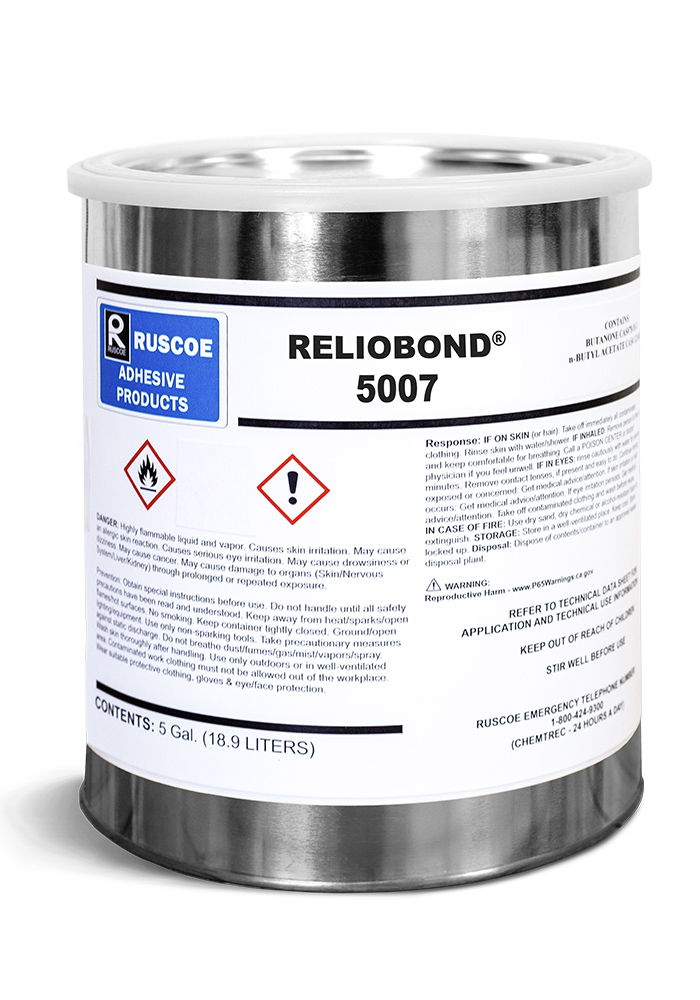Reliobond® 5007 Friction Bonding Adhesive
Reliobond® 5007 is a nitrile rubber and phenolic resin adhesive designed for bonding friction material to metal. This adhesive offers high bond strength across a wide range of temperatures. Cured Reliobond 5007 has excellent resistance to oil, grease, transmission fluid and brake cleaning fluid. Reliobond 5007 is designed specifically for curtain coating application but can be brush or roll coated. It is particularly well suited for bonding low density friction paper due to its low flow nature during cure.
SUGGESTED USES
Used heavily in brake, paper, clutch and transmission part applications.

Reliobond® 5007 should be thoroughly mixed before application. Mix the product before application using a high shear mixing blade, pail tumbler or drum roller for 30 minutes to 1 hour. Reliobond 5007 can be reduced to a desired viscosity/solids by using methyl ethyl ketone, acetone, n-butyl acetate, methyl acetate or t-butyl acetate in any proportion. Toluene, xylene and alcohols can be used in small amounts but will destabilize the product if too much is added.
DRYING
Reliobond 5007 must be fully dried before curing. Residual solvent in the adhesive can cause a weak, “spongy”, “blown” bond. It is difficult to recommend exact drying parameters. Environmental conditions, coating thickness and drying equipment type all significantly affect dry time. Here are some general guidelines for drying:
- Drying oven temperatures can range from 100°F-250°F (38°C-121°C). Do not exceed 250°F (121°C) as higher temperatures can prematurely cure the adhesive or cause blistering of the adhesive film.
- Air flow in the drying oven is crucial to achieving fast dry times. More air flow will reduce dry time.
- Contact Ruscoe Technical Service for a test procedure to determine if your part is fully dried.
CURING
The phenolic resins in Reliobond 5007 generate water vapor during cure. This water vapor must be forced out of the adhesive using pressure during the cure cycle. Most bonding problems with this type of adhesive are related to inadequate or uneven pressure. At least 100 psi must be continuously and uniformly applied during the curing process to ensure a good bond.
Reliobond 5007 adhesive will cure in the temperature range of 300°F-450°F (148°C-232°C). Keep in mind that this is the temperature that the adhesive must reach, not the oven setting. The adhesive will take longer to cure at lower temperatures but will allow more time for water vapor to escape and for adhesive to flow and wet the metal surface. Curing at too high of a temperature can cause the adhesive to gel quickly which will trap water vapor in the adhesive and cause a weak bond.
Experimentation is required to determine the optimum cure cycle for each part design. A good starting point is to cure for 30 minutes at 400°F (204°C) at 200 psi.
Reliobond® 5007 is flammable and should be stored in tightly sealed containers away from direct sunlight, heat, sparks, or other potential sources of ignition. Shelf life is 12 months when stored 40°F-60°F (4°C-16°C) in unopened containers. Storage at temperatures above 60oF will cause eventual loss of adhesive performance. Parts that have been coated and dried can be bonded within 12 months if stored in a clean, dry area at temperature below 100°F (30°C).
Health and safety data sheets available upon request at The Ruscoe Company.
Typical Properties:
| Color | Black | |
| Solids | 28-32% | |
| Solvent Formulation | Methyl Ethyl Ketone | |
| Viscosity, Brookfield, Spindle # | #4 | |
| Viscosity, Brookfield, Test RPM | 10 rpm | |
| Viscosity, Brookfield, Test Result, CPS | 2,000 – 3,000 | |
| Pounds Per Gallon @77°F (25°C) | 7.5-7.7 | |
| Shelf Life | 12 Months |
Performance Properties:
| Shear Strength (@75°F) | 5,600 psi | |
| Shear Strength (@400°F) | 1,400 psi | |
| “Button & Bar” Shear Strength Test (SAE J840 Rev C) | Cured 1 hour @ 425°F and 200 psi |
